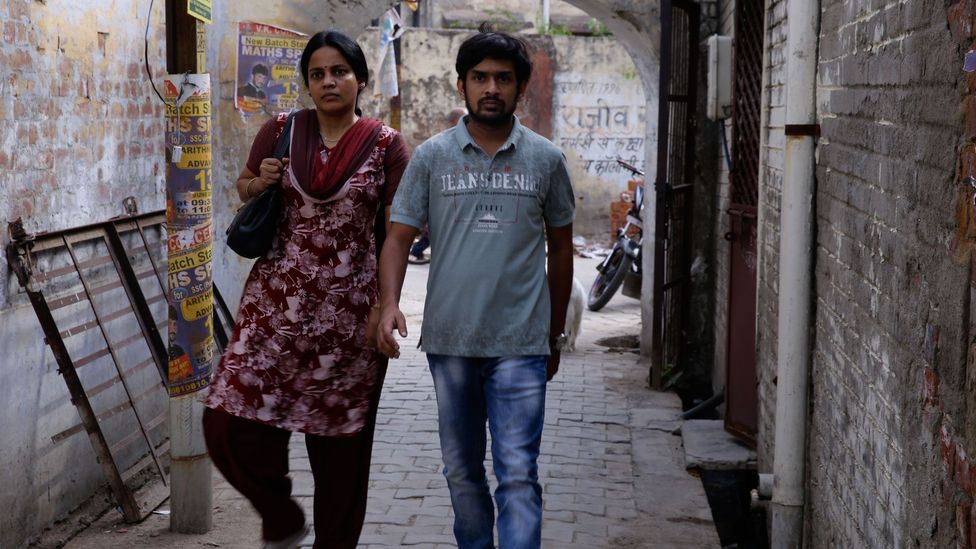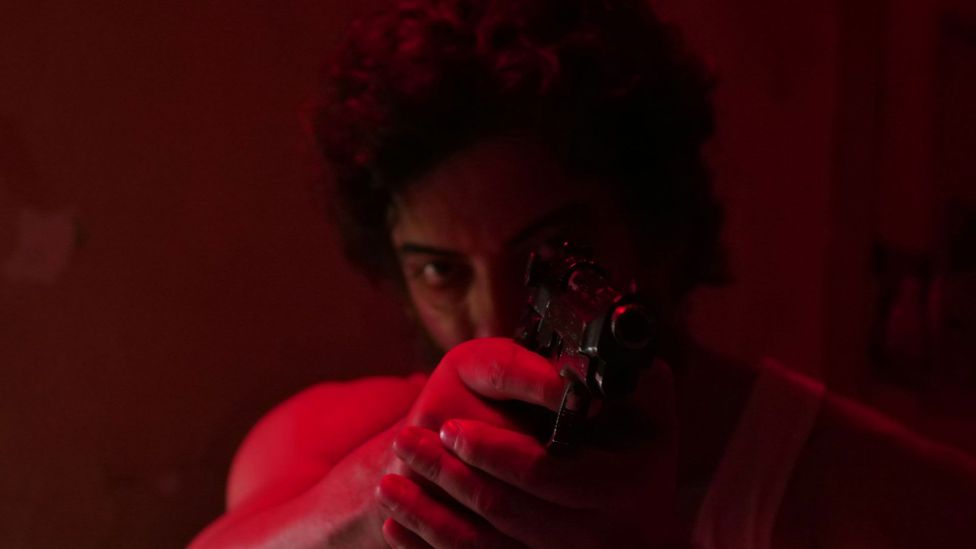One of the things Indian cinema is known for all around the world, as well as song-and-dance numbers, is its chasteness, as a result of popular Bollywood productions, which historically didn’t even allow for kissing on screen, let alone sex scenes. Indeed, Bollywood directors over the last century have had to find ways to depict sexiness in understated, suggestive ways that get past the disapproving glare of the controlling censors – like a big number featuring a demure actress in a white sari running through a fountain, for example.
More like this:
– The power of Cannes hit How to Have Sex
– Cannes review: The Zone of Interest is ‘a masterpiece’
– The new wave of provocative Indian TV
But anyone who imagines that all Indian cinema is so innocent was in for a big surprise at this year’s Cannes Film Festival. Director Kanu Behl’s Agra, which played last Thursday in the Director’s Fortnight sidebar section, is a shocking and forthright look at sexually repressed men in India that is replete with nudity and explicit sex scenes. It is also the latest addition to a lineage of transgressive, alternative Indian cinema that barely gets talked about. As Behl himself says: “There are so many films made in India, and there is a split personality, almost like two different ideas of Indian cinema that are there. There is the much more popular Bollywood version of Indian cinema, which a lot more people know about, and there is also the parallel independent film world where a lot of interesting work has happened, not just now or in the past 5 or 10 years, but over decades.

Agra looks at the issue of sexual violence in India through the story of one disturbed man (Credit: Saregama India/UFO Production/O28 Films)
Agra tells the story of a repressed call centre employee named Guru, who lives in a small house with his parents and married siblings. There is no space for him to have a partner or a sex life without everyone in his cramped household knowing and commenting, so he wants to have an extension built. Wildly frustrated, Guru spends his days addicted to dating apps and acts out a series of violent sexual fantasies, though Behl never makes clear whether these are real events, or figments of Guru’s imagination. There is a touch of American Psycho’s Patrick Bateman in how Guru’s obsessions and delusions blur fact and fiction. It’s a bold film where the first sex scene ends with a woman turning into a giant rodent, and we begin to realise that Guru is a fantasist.
While this scene has an air of the absurd, Behl doesn’t shy away from showing some of Guru’s more angry and violent fantasies. It’s shocking and, at times, unbearable to watch as the Indian director tries to take the spectator inside the dangerous mind of a very sick man fantasising about overpowering women and asserting his masculinity.
“The film looks at certain secret spaces in everybody’s lives, which no one wants to talk about,” says the 42-year-old director. “There was this sexual repression that I had felt growing up as a boy in northern India, and not just me, I had seen so many people struggling with the delayed sexual maturity,” Behl adds.
Behl’s film examines the problem of sexual repression, and suggests that it is connected to India’s especially high sexual violence rates. Although the film doesn’t try to look at the broader picture of sexual violence in India, the subtext is that men’s sexual immaturity is one of the drivers making India “one of the most dangerous places to be a woman”, as a 2021 Guardian report suggested. In 2012, a brutal gang rape and murder of a student on a bus in Delhi ensured India’s high sexual violence rates were brought to the world’s attention. In the aftermath of the incident, the Indian parliament introduced stiffer penalties for sexual crimes, but it seems to have made little difference to the crime rates. Rape reports have risen, and many more are scared to come forward. In reflecting on this dark subject matter through the story of one disturbed man, Bhel has made a film that has broken many taboos, even if that wasn’t the director’s intention. “I didn’t set out to break any taboos, but the subject forced me to do so,” he says.
The whole issue of sexual mores and sexual violence in India was a subject that was tricky for Behl to face. His first draft of the story didn’t show explicit sexual scenes. While attending the Three Rivers residency for filmmakers, it was pointed out to him that he had to visualise the ugly and darker side of the story for the audience to comprehend the extent that his repression had warped his physical desires. “The tutor read a draft and asked me why I was making the film, and I said because I want to deal with sexual repression and physical spaces in India. The tutor said, then why are you not doing it? If you really want to do it, you can’t do it in a half-baked manner. That night I decided that to make a film about a deeply vulnerable person who doesn’t know how to deal with the opposite sex. I had to show how they behave in dastardly, unexpected ways.”
The DNA of Indian cinema
Behl follows in fine footsteps – for the darker side of Indian cinema has always existed, says Meenakshi Shedde, India and South Asia delegate for the Berlin Film Festival and a senior programme advisor to the Toronto Film Festival, who is sitting on the Critic’s Week jury at Cannes this year. “We have always had a potent transgressive gene. It’s not been dominant, but it’s been in the DNA of Indian cinema from the very beginning. It’s probably common in a lot of cultures where at the birth of cinema, it was only transgressive people making films. In India, it was the low caste, the marginalised, and the migrants making movies because it was considered sleazy to work in films.”

Neo-noir Kennedy is another Indian film at this year’s Cannes that is pushing boundaries (Credit: Zee Studios/Good Bad Films)
The 1913 silent film Raja Harishchandra, often considered to be India’s first feature-length movie, popularised cinema in India, but such was the low esteem the seventh art was held in at the time that director Dadasaheb Phalke had to get a male actor to play the female lead. Just being in the film industry was a transgressive act.
“And that [transgressive] streak has long continued, gathering momentum in the 1950s into the 1970s with the Parallel cinema moment. If you look at Satyajit Ray’s films, for example, Pather Panchali was made in 1955, and a lot of his contemporaries and distinguished fellow artists, including Mrinal Sen and Ritwik Ghatak, did very transgressive, political cinema that questioned what was going on.”
Yet that independent strand of Indian cinema was long hard to find, especially outside India, where it was mainstream Bollywood films, with the traditional “masala” formula of romance, songs and happy endings, that were the ones that travelled. And by the 1990s, the alternative Indian movement had largely vanished due to the rising costs of filmmaking, with Bollywood gaining momentum and eating up all the space by tapping into the non-Indian resident market overseas. The economic realities led to a lack of desire from Indian exhibitors to release anything but the Hindi cinema mainstream.
However the rise of digital technology in the 21st Century, resulting in filmmaking becoming cheaper, has led to a revival of independent Indian cinema in recent years, with filmmakers such as Shonali Bose and Anurag Kashyap rising to prominence. As censorship has relaxed, the topics being tackled have broadened, with films looking at troubling political histories and social causes such as LGBTQ rights. These films have found audiences at festivals such as Berlin and Cannes. Kashyap’s latest film, the neo-noir Kennedy, purporting to be based on real-life police corruption in India, is playing in the Midnight Section of the Cannes Film Festival, a section that celebrates cinema that pushes the boundaries.
And as this strand of Indian cinema has begun finding more critical acclaim around the world, it has also had an impact on popular Bollywood cinema, with the studios having to adapt their films to the changing tastes of the audience, making them less chaste and tackling daring subject matters. “This has led to the ‘masala’ guys of Bollywood dealing with more topical subjects in realistic ways,” says Shedde, who also points out conversely that filmmakers from the independent scene have been “embracing song-and-dance to be more accessible to a large audience.”
It’s certainly an exciting time for Indian cinema, with the promise of an era of rich, diverse and divisive films that are more in tune with Indian cinema’s transgressive roots than the Bollywood output that took over. These films hold a mirror up to society and like the works of Gaspar Noé, Jack Smith and Kenneth Anger (who died this week), to name three filmmakers, they are by their nature incredibly divisive and at times extremely difficult to watch. Agra fits into this mould. Behl so successfully manages to get us into Guru’s psyche that the film becomes abhorrent, attacking our senses and creating an unpleasant visceral reaction. Even as the plot widens to include money-lending, the distinction between fact and fiction is difficult to discern, which some will find powerfully unnerving, and others may find simply confusing. But the best thing about Behl’s is work that it manages to tackle one of India’s biggest and least talked-about issues without feeling like a lecture. May more and more Indian cinema be just as provocative and creatively bold.